The Biomechanics of Clays Shooting
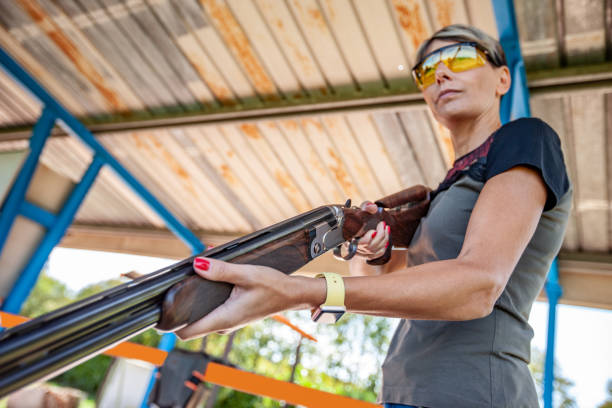
Biomechanics is the study of the action of internal and external forces on the living body, especially on the skeletal system, which includes the analysis of motion. When we’re engaged in tournament clay target shooting (Trap, Skeet, or Sporting Clays) it’s crucial that we apply the proper or correct biomechanics with regard to our posture, form, and movement. This certainly helps us to endure the least amount of body stress and fatigue as we engage in lengthy tournament situations. As I work with students, from novice to advanced, one of the first things we review is their “most comfortable shooting position.” From that we’ll then make whatever adjustments or corrections are needed so as to incorporate the proper shooting form and posture.
I’m not planning to go deep into the biomechanics of the human body here, but when we shoot competitively for long periods of time, we need to make certain that we’re properly engaging our legs, back, neck, shoulders, and arms in the performance of every single shot. When we don’t use the proper form or posture when shooting, stress, fatigue, aches, and even pain, can set in and our accuracy or performance will suffer. What I hope to do here is simply make you aware of the importance of proper set-up and positioning of your body for every shot, and to provide you with some basic ideas and techniques that can help you analyze and improve your shooting comfort, accuracy, and endurance.
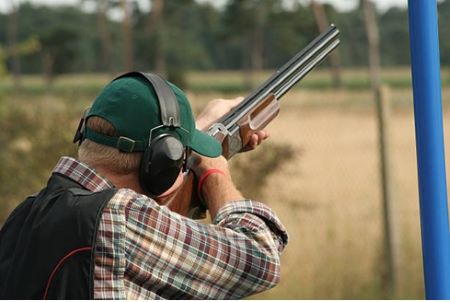
Let’s start with your arms, neck, and shoulders: Competitive shotguns will weigh on average about 8½ pounds. Obviously, we need a certain amount of basic muscle strength to simply swing and control the shotgun comfortably and accurately. However, when we add additional stress to the muscles because of improper balance or by over-gripping or tensing-up on every shot, we induce unnecessary fatigue which robs our endurance.
Here are a few things to keep in mind as you mount the shotgun. Your forend arm and hand are what guide and control the elements of your swing. Don’t over-extend your arm on the forend wood; keep your grip near the mid-position point as much as possible. Don’t flatten the strength triangle formed by your bent arm and the shotgun. Relax the tension in your wrist and hand but maintain a firm and comfortable grasp. Make certain to keep your elbow relaxed, yet in a supportive and weight-bearing position, slightly beneath the shotgun.
To reduce fatigue in your stock-gripping hand and arm, simply wrap your thumb over the stock and keep your wrist straight and in-line with your forearm as much as possible. Some shooters like to keep their elbow out at 90 degrees; this is an unnatural position and can induce additional stress in the arms and shoulders. I recommend you keep your shoulder relaxed and your elbow at around a 45-degree angle. This is a more natural position and will actually allow for better gun support, comfort, and control. As you start your gun mount, keep it level with the ground and un-canted. Move it outward slightly as you raise it to the level position (never above eye-level), and then pull it back gently into your shoulder pocket. When you raise your shotgun above the eye-level position, you’re unnecessarily interrupting your field of vision and momentarily breaking your mental focus, which should be out into the breaking zone. As soon as your gun touches your shoulder, start moving your face down toward the comb. Be sure to maintain slight backward pressure on the stock into your shoulder pocket, it should be firm but not tense or over-stressed.
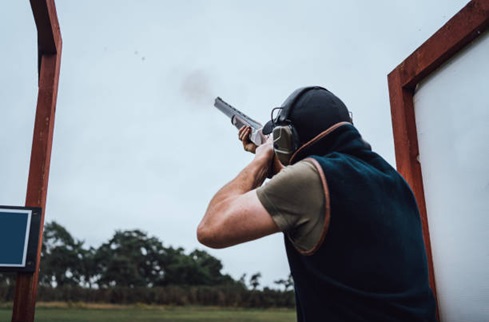
Now, move your head slightly forward and down onto the stock to achieve the proper eye/rib/bead/barrel alignment. This is where proper gun-fit and gun set-up becomes critical. Use only mild pressure as you lay your cheek on the comb of the stock to achieve eye alignment, don’t force your face hard onto the comb. Applying to much pressure can result in unnecessary pain (bruising) and vision distortion as you prepare for the shot. Don’t hunch your shoulders; focus on keeping them relaxed and your neck straight and comfortable. You should practice this whole gun mounting and muscle relaxing routine so it becomes one fluid motion and exercise as you prepare for each and every shot. You can also keep your shoulders relaxed by slightly forcing your shoulder blades gently down and together in back. This enables all of your shoulder (rotator cuff) muscles and tendons to properly respond as needed throughout the shot process.
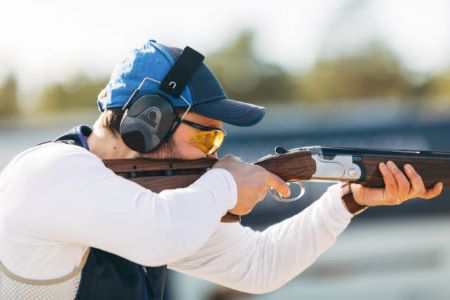
Now, let’s focus on your hips, waist and lower back: As you lean forward putting slight pressure on your lead foot (which is about 60% of your body weight) keep your low-back and hips relaxed and in straight vertical alignment. In skeet, I’ve noticed a number of shooters that go into a slight crouching position just prior to calling for the target. Some believe this makes them more focused and aggressive, or that they see the target better? I believe this just puts a lot of unnecessary stress on the legs and low back, which invites more aches, pain, and fatigue. As you place weight forward on the lead foot, be certain to maintain good balance and ground contact with both feet. Always set your foot position for the desired target break point. Then, rotate at the waist and face your upper body toward the desired gun hold point. Remember, to maintain your “Comfortable Shooting Position” toward the desired target break point. As you call for the target, slightly tighten your stomach muscles as you unwind for the shot, this helps with strength, stability, and control of movement.
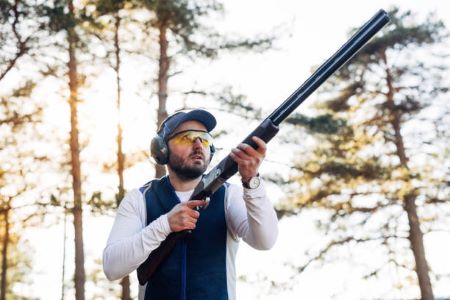
Finally, let’s talk about your legs, knees, ankles and feet: Many shooters will use only their upper-body when taking the shot. They’ll use their legs (including knees, ankles, and feet) only for support and stability. That’s certainly important; but applying proper shooting technique involves the use of your legs to drive the upper body toward, and through the target. This is especially true for skeet and sporting clays shooters as they will track and swing through the many angled targets presented. Even though trap shooting has less body movement, you’re still using your legs to provide a slight push toward the target.
By making minor adjustments in my ankle and foot positions, I’ve been able to reduce or eliminate hip, low-back, and knee aches and pains. As most shooters set-up for the shot, it only takes a few seconds to recognize and analyze the bio-feedback (or messages) coming from your body. The key is to pay attention and be open and receptive to what your body is telling you, then to make the slight adjustments necessary to relieve any pressure, tension, or stress.
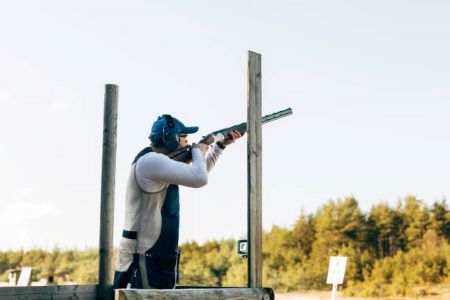
Awareness leads to improvement. When you set-up for every shot, simply pay attention to what your body is feeling; your joints, muscles, nerves and tendons. With sensitivity and awareness, you should be able to focus instantly on relaxing or relieving that tension or stress that can ruin your success. Understand that your body is a very complex and delicate biomechanical machine, and for peak performance it’s crucial that you learn to take care of it properly. Mental and muscle fatigue kills performance! Just before every shot on every post or station, if you simply take a moment and realizing what your body is telling you, you’ll be able to make those immediate and necessary corrections so you can stay relaxed and focused to break every target every time.
Frank Neumayer has been shooting shotguns since he was 12 years old. He’s hunted all types of upland birds and waterfowl in all types of weather conditions and terrain throughout the Pacific Northwest. He’s enjoyed many years of clay target shooting in club and league shoots; State and Zone shoots; to World Class tournaments all over the country. Frank’s been an “A – AA” Class shooter in both the Pacific International Trapshooting Association (PITA) and the Amateur Trapshooting Association (ATA), and he’s earned his way back to the 27 yard line in both Associations. Frank enjoys all of the clay target sports, but his primary focus is on perfecting and teaching American Trap and Skeet shooting. Visit his web site at http://www.claybrakn.com
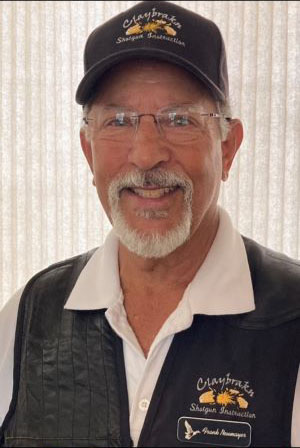
Frank Neumayer has been shooting shotguns since he was 12 years old. He’s hunted all types of upland birds and waterfowl in all types of weather conditions and terrain throughout the Pacific Northwest. He’s enjoyed many years of clay target shooting in club and league shoots; State and Zone shoots; to World Class tournaments all over the country. Frank’s been an “A – AA” Class shooter in both the Pacific International Trapshooting Association (PITA) and the Amateur Trapshooting Association (ATA), and he’s earned his way back to the 27 yard line in both Associations. Frank enjoys all of the clay target sports, but his primary focus is on perfecting and teaching American Trap and Skeet shooting. Visit his web site at http://www.claybrakn.com


Comments